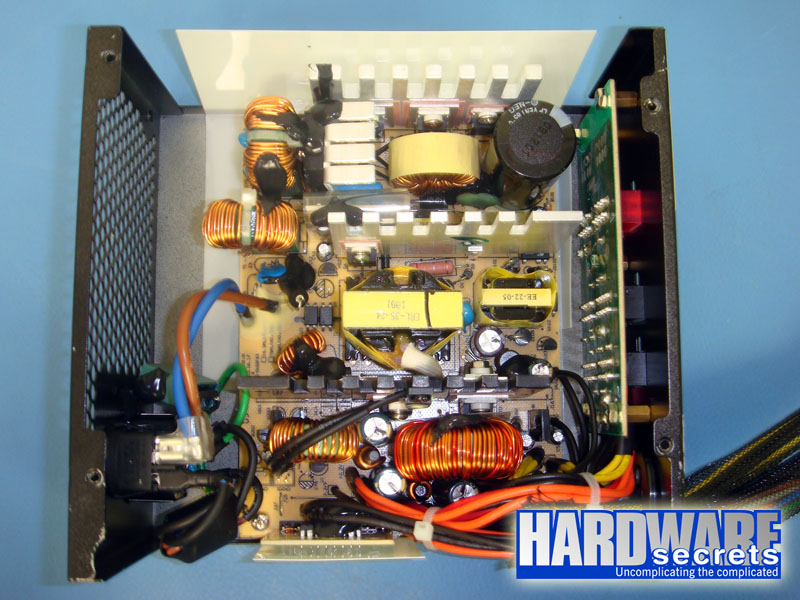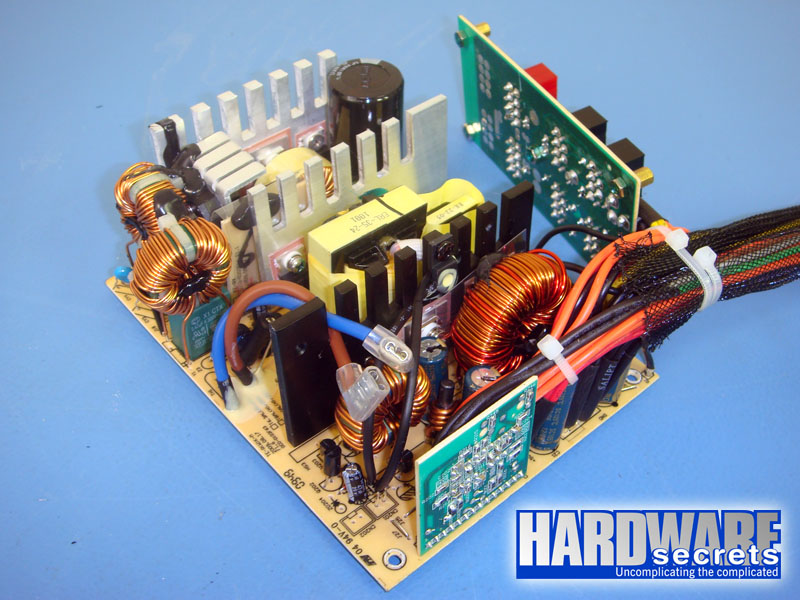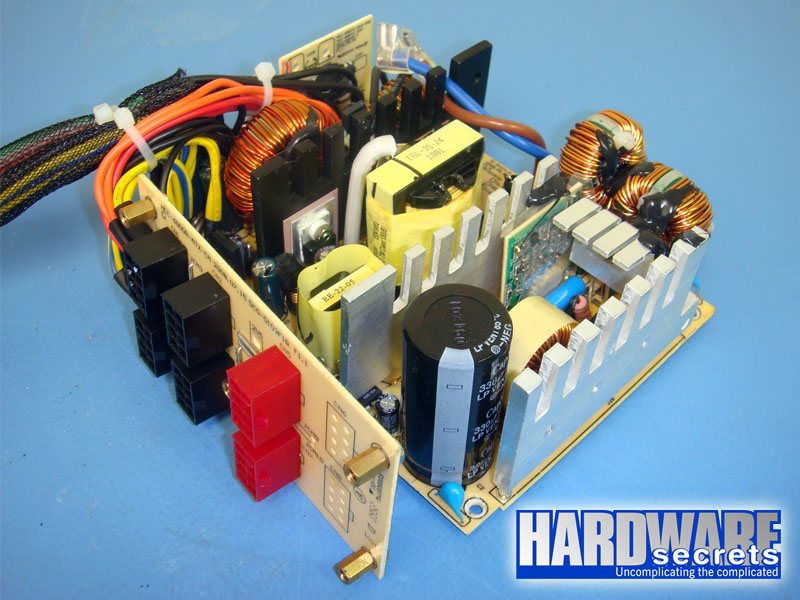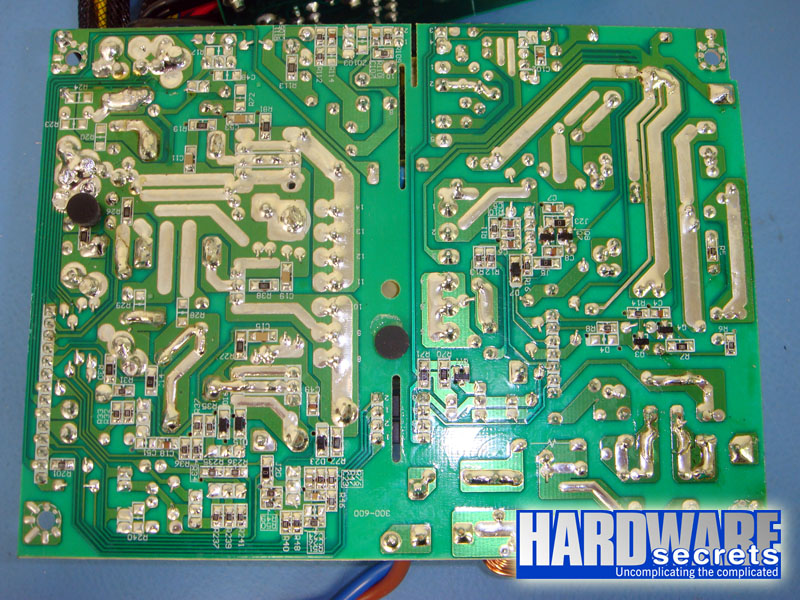[nextpage title=”Introduction”]
The Aerocool E85M-550 is a 550 W power supply with a modular cabling system, and the manufacturer promises 85% efficiency. For some reason this unit is sold only outside the United States.
This power supply is manufactured by HEC/Compucase and it uses the exact same design as the Aerocool V12XT-600 that we reviewed recently.
 Figure 1: Aerocool E85M-550 power supply
Figure 1: Aerocool E85M-550 power supply
 Figure 2: Aerocool E85M-550 power supply
Figure 2: Aerocool E85M-550 power supply
The Aerocool E85M-550 is 6.3” (160 mm) deep, using a 140 mm fan on its bottom. The fan part number, DFS132512H, makes us believe that it is a sleeve bearing model manufactured by YongLinXing Electronics, even though the brand, “Aerocool,” is printed on it. The fan glows in blue when turned on.
This unit features active PFC, of course.
It comes with a modular cabling system with six connectors, two red ones for video card power cables and four white ones for peripheral and SATA power connectors. Two cables are permanently attached to the power supply. The cables included are the following:
- Main motherboard cable with a 20/24-pin connector, 19.3” (49 cm) long (permanently attached to the power supply)
- One cable with two ATX12V connectors that together form an EPS12V connector, 18.9” (48 cm) long (permanently attached to the power supply)
- Two cables, each with one six/eight-pin connector for video cards, 20” (51 cm) long (modular cabling system)
- Two cables, each with three SATA power connectors, 20” (51 cm) to the first connector, 5.9” (15 cm) between connectors (modular cabling system)
- One cable with three standard peripheral power connectors and one floppy disk drive power connector, 20” (51 cm) to the first connector, 5.9” (15 cm) between connectors (modular cabling system)
All wires are 18 AWG, except the orange (+3.3 V) wires in the main motherboard cable, which are thicker (16 AWG).
Although the E85M-550 is based on the same design as the V12XT-600, the cable configuration is different. The V12XT-600 comes with separate ATX12V and EPS12V cables, the video card cables have one additional connector each, there is one more SATA connector on each SATA cable, and it comes with one additional cable carrying three peripheral power connectors. Another difference between the two models is the presence of LEDs illuminating the modular cabling system, a feature not available on the E85M-550.
Now let’s take an in-depth look inside this power supply.
[nextpage title=”A Look Inside The Aerocool E85M-550″]
We decided to disassemble this power supply to see what it looks like inside, how it is designed, and what components are used. Please read our Anatomy of Switching Power Supplies tutorial to understand how a power supply works and to compare this power supply to others.
This page will be an overview, and then in the following pages we will discuss in detail the quality and ratings of the components used. As already explained, the Aerocool E85M-550 uses the same design as the V12XT-600 model from the same manufacturer. In the following pages we will see whether they are the same power supply or not.
 Figure 4: Top view
Figure 4: Top view
 Figure 5: Front quarter view
Figure 5: Front quarter view
 Figure 6: Rear quarter view
Figure 6: Rear quarter view
 Figure 7: Printed circuit board
Figure 7: Printed circuit board
[nextpage title=”Transient Filtering Stage”]
As we have mentioned in other articles and reviews, the first place we look when opening a power supply for a hint about its quality, is its filtering stage. The recommended components for this stage are two ferrite coils, two ceramic capacitors (Y capacitors, usually blue), one metalized polyester capacitor (X capacitor), and one MOV (Metal-Oxide Varistor). Very low-end power supplies use fewer components, usually removing the MOV and the first coil.
In this power supply, this stage is flawless. It has two X capacitors, two Y capacitors and one MOV more than the minimum required, plus one X capacitor after the rectifying bridge.
 Figure 8: Transient filtering stage (part 1)
Figure 8: Transient filtering stage (part 1)
 Figure 9: Transient filtering stage (part 2)
Figure 9: Transient filtering stage (part 2)
In the next page we will have a more detailed discussion about the components used in the Aerocool E85M-550.
[nextpage title=”Primary Analysis”]
On this page we will take an in-depth look at the primary stage of the Aerocool E85M-550. For a better understanding, please read our Anatomy of Switching Power Supplies tutorial.
This power supply uses one PBU1005 rectifying bridge on its primary, and it is connected to an individual heatsink. This component supports up to 10 A at 100° C, so in theory, you would be able to pull up to 1,150 W from a 115 V power grid. Assuming 80% efficiency, the bridge would al
low this unit to deliver up to 920 W without burning itself out. Of course, we are only talking about these components, and the real limit will depend on all the other components in this power supply. This is exactly the same component used in the Aerocool V12XT-600.
The active PFC circuit uses two FDP18N50 MOSFETs, each one capable of delivering up to 18 A at 25° C or up to 10.8 A at 100° C in continuous mode (note the difference temperature makes), or up to 72 A in pulse mode at 25° C. These transistors present a 265 mΩ resistance when turned on, a characteristic called RDS(on). The lower this number the better, meaning that the transistors will waste less power and the power supply will have a higher efficiency. The Aerocool V12XT-600 uses more powerful transistors here (20.7 A at 25° C, or 13.1 A at 100° C), which present a lower RDS(on) (190 mΩ).
 Figure 11: Active PFC transistors and diode
Figure 11: Active PFC transistors and diode
The electrolytic capacitor used to filter the output of the active PFC circuit is from CapXon and labeled at 85° C.
In the switching section, another two FDP18N50 power MOSFET transistors are used in the traditional two-transistor forward configuration. The specs for these transistors were already published above. The Aerocool V12XT-600 again uses more powerful transistors here (20.7 A at 25° C, or 13.1 A at 100° C), which present a lower RDS(on) (190 mΩ).
 Figure 12: One of the switching transistors
Figure 12: One of the switching transistors
The primary is controlled by the famous CM6800 active PFC/PWM combo.
 Figure 13: Active PFC/PWM combo controller
Figure 13: Active PFC/PWM combo controller
Now let’s take a look at the secondary of this power supply.
[nextpage title=”Secondary Analysis”]
This power supply has four Schottky rectifiers attached to the secondary heatsink.
The maximum theoretical current each line can deliver is given by the formula I / (1 – D), where D is the duty cycle used and I is the maximum current supported by the rectifying diode. Just as an exercise, we can assume a typical duty cycle of 30%.
The +12 V output is generated using two SBR30A50CT Schottky rectifiers connected in parallel, each one having a current limit of 30 A (15 A per internal diode at 110° C, 0.55 V maximum voltage drop). This gives us a maximum theoretical current of 43 A or 514 W for the +12 V output. The V12XT-600 uses two 40 A rectifiers here (57 A/686 W maximum theoretical output).
The +5 V output is generated using one STPS30L45CT Schottky rectifier, which is able to handle up to 30 A (15 A per internal diode at 110° C, 0.74 V maximum voltage drop). This gives us a maximum theoretical current of 21 A or 107 W for the +5 V output. The V12XT-600 uses a different component here, but with the same specs.
The +3.3 V output is generated using another STPS30L45CT Schottky rectifier. This gives us a maximum theoretical current of 21 A or 107 W for the +3.3 V output. The V12XT-600 uses two 30 A rectifiers here (43 A/141 W maximum theoretical limit).
Of course these are all theoretical figures. The real current limits will depend on other components, especially on the coil used.
 Figure 14: The +5 V and one of the +12 V rectifiers
Figure 14: The +5 V and one of the +12 V rectifiers
 Figure 15: The other +12 V and the +3.3 V rectifiers
Figure 15: The other +12 V and the +3.3 V rectifiers
The outputs are monitored by a WT7525 integrated circuit. This circuit supports over voltage (OVP), under voltage (UVP), and over current (OCP) protections. This circuit offers four over current protection channels (one for +3.3 V, one for +5 V, and two for +12 V), correctly matching the number of +12 V rails advertised by the manufacturer (two).
The electrolytic capacitors available in the secondary are from Teapo and labeled at 105° C.
[nextpage title=”Power Distribution”]
In Figure 17, you can see the power supply label containing all the power specs.
This power supply has two +12 V rails, and we can confirm that the over current protection (OCP) circuit supports two +12 V channels, and the unit has the necessary “shunts” (current sensors).
The available rails are distributed like this:
- +12V1 (solid yellow wire): Main motherboard cable, SATA connectors, peripheral connectors, and one of the video card connectors
- +12V2 (yellow/blue wire): ATX12V/EPS12V connectors, and one of the video card connectors
Now let’s see if this power supply can really deliver 550 W.
[nextpage title=”Load Tests”]
We conducted several tests with this power supply, as described in the article, Hardware Secrets Power Supply Test Methodology.
First we tested this power supply with five different load patterns, trying to pull around 20%, 40%, 60%, 80%, and 100% of its labeled maximum capacity (actual percentage used listed under “% Max Load”), watching the behavior of the reviewed unit under each load. In the table below, we list the load patterns we used and the results for each loa
d.
If you add all the power listed for each test, you may find a different value than what is posted under “Total” below. Since each output can vary slightly (e.g., the +5 V output working at +5.10 V), the actual total amount of power being delivered is slightly different than the calculated value. In the “Total” row, we are using the real amount of power being delivered, as measured by our load tester.
The +12VA and +12VB inputs listed below are the two +12 V independent inputs from our load tester. During this test the +12VA input was connected to the power supply +12V1 rail, while the +12VB input was connected to the power supply +12V2 rail (EPS12V connector).
| Input | Test 1 | Test 2 | Test 3 | Test 4 | Test 5 |
| +12VA | 4 A (48 W) | 8 A (96 W) | 12 A (144 W) | 16 A (192 W) | 22.5 A (270 W) |
| +12VB | 4 A (48 W) | 8 A (96 W) | 12 A (144 W) | 16 A (192 W) | 22 A (264 W) |
| +5V | 1 A (5 W) | 2 A (10 W) | 4 A (20 W) | 5 A (25 W) | 6 A (30 W) |
| +3.3 V | 1 A (3.3 W) | 2 A (6.6 W) | 4 A (13.2 W) | 5 A (16.5 W) | 6 A (19.8 W) |
| +5VSB | 1 A (5 W) | 1 A (5 W) | 1.5 A (7.5 W) | 2 A (10 W) | 2.5 A (12.5 W) |
| -12 V | 0.5 A (6 W) | 0.5 A (6 W) | 0.5 A (6 W) | 0.5 A (6 W) | 0.5 A (6 W) |
| Total | 113.5 W | 215.7 W | 328.2 W | 430.2 W | 551.2 W |
| % Max Load | 20.6% | 39.2% | 59.7% | 78.2% | 100.2% |
| Room Temp. | 45.1° C | 44.1° C | 44.7° C | 47.3° C | 46.7° C |
| PSU Temp. | 43.8° C | 44.1° C | 45.0° C | 46.7° C | 49.8° C |
| Voltage Regulation | Failed in -12 V | Pass | Pass | Pass | Pass |
| Ripple and Noise | Pass | Pass | Pass | Pass | Pass |
| AC Power | 134.9 W | 252.9 W | 389.3 W | 521.1 W | 694.0 W |
| Efficiency | 84.1% | 85.3% | 84.3% | 82.6% | 79.4% |
| AC Voltage | 112.4 V | 110.9 V | 110.1 V | 108.5 V | 106.6 V |
| Power Factor | 0.986 | 0.968 | 0.981 | 0.987 | 0.991 |
| Final Result | Fail | Pass | Pass | Pass | Pass |
The Aerocool E85M-550 can really deliver its labeled wattage at high temperatures.
Since it is based on the same design as the V12XT-600, it presented the exact same performance – and flaws.
Efficiency was high (85.3% peak) when we pulled from 20% to 80% (i.e., from 110 W to 440 W) from its labeled maximum power. At full load load (550 W), however, efficiency dropped to 79.4%. As we always point out, Ecos Consulting, the company behind the 80 Plus certification, tests power supplies at 23° C, and we test power supplies at 45° or higher, and efficiency drops with temperature. So we believe our results to be more realistic.
Voltage regulation was faulty during test one, with the -12 V output above the maximum allowed, at -10.66 V (the maximum allowed is -10.80 V, or 10%). During all other tests, voltages were inside specifications.
Noise and ripple, though always inside specs, were very high during test five, with the +12 V outputs almost touching the 120 mV limit. The X12XT-600 also presented a high noise level at +3.3 V output, which wasn’t observed on the E85M-550. Below you can see the results for the power supply outputs during test number five. The maximum allowed is 120 mV for +12 V and -12 V and 50 mV for +5 V and +3.3 V. All values are peak-to-peak figures.
 Figure 18: +12VA input from load tester during test five at 551.2 W (117.2 mV)
Figure 18: +12VA input from load tester during test five at 551.2 W (117.2 mV)
 Figure 19: +12VB input from load tester during test five at 551.2 W (107.4 mV)
Figure 19: +12VB input from load tester during test five at 551.2 W (107.4 mV)
 Figure 20: +5V rail during test five at 551.2 W (21.2 mV)
Figure 20: +5V rail during test five at 551.2 W (21.2 mV)
 Figure 21: +3.3 V rail during test five at 551.2 W (28.6 mV)
Figure 21: +3.3 V rail during test five at 551.2 W (28.6 mV)
Let’s see if we can pull even more from the Aerocool E85M-550.
[nextpage title=”Overload Tests”]
Below you can see the maximum we could pull from this power supply. If we tried to increase one amp at any given output, the unit would shut down, showing that one of its protections kicked in, which is always the desired behavior. During this test, the noise level at +12 V outputs was above the maximum allowed, at 155 mV, and voltages were below the minimum allowed, at +11.10 V.
| Input | Overload Test |
| +12VA | 28 A (336 W) |
| +12VB | 28 A (336 W) |
| +5V | 6 A (30 W) |
| +3.3 V | 6 A (19.8 W) |
| +5VSB | 2.5 A (12.5 W) |
| -12 V | 0.5 A (6 W) |
| Total | 609.4 W |
| % Max Load | 110.8% |
| Room Temp. | 34.2° C |
| PSU Temp. | 45.3° C |
| AC Power | 784.0 W |
| Efficiency | 77.7% |
| AC Voltage | 104.8 V |
| Power Factor | 0.994 |
[nextpage title=”Main Specifications”]
The specs of the Aerocool E85M-550 include:
- Nominal labeled power: 550 W
- Measured maximum power: 609.4 W at 34.2° C ambient
- Labeled efficiency: up to 85%, 80 Plus Bronze certification
- Measured efficiency: Between 79.4% and 85.3% at 115 V (nominal, see complete results for actual voltage)
- Active PFC: Yes
- Modular Cabling System: Yes, partial
- Motherboard Power Connectors: One 20/24-pin connector and two ATX12V connectors that together form an EPS12V connector (permanently attached to the power supply)
- Video Card Power Connectors: Two cables with one six/eight-pin connector each (modular cabling system)
- SATA Power Connectors: Six on two cables (modular cabling system)
- Peripheral Power Connectors: Three on one cable (modular cabling system)
- Floppy Disk Drive Power Connectors: One
- Protections: Over voltage (OVP), over current (OCP), and short-circuit (SCP) – although not listed by the manufacturer, this unit has under voltage protection (UVP)
- Warranty
: Information not available - Real Manufacturer: HEC/Compucase
- More Information: https://www.aerocool.com.tw
- Average price in the US: This product isn’t sold in the USA
[nextpage title=”Conclusions”]
The Aerocool E85M-550 is basically a V12XT-600 with downgraded components and less cables. It exhibits the same performance and flaws found in its big sister.
Efficiency really peaked at 85% as promised by the manufacturer, but at full load its efficiency was below 80%. This unit has 80 Plus Bronze certification, and should present efficiency of at least 82% at full load. As we always point out, Ecos Consulting, the company behind the 80 Plus certification, tests power supplies at 23° C, and we test power supplies at 45° or higher, and efficiency drops with temperature. So we believe our results to be more realistic.
Voltage regulation failed on the -12 V during our light load (20% load, meaning 110 W) test, but all other voltages were inside specs during all tests.
Although inside specs, noise and ripple were very high when the unit was delivering 550 W.
In summary, we think that there are better options on the market if you are looking for a good 550 W or 600 W power supply (e.g., the OCZ ModXStream Pro 600 W, the Cooler Master Silent Pro M 600 W, and the Huntkey Jumper 550).





Leave a Reply